Holmes Institute Advanced Accounting: Estia Health Limited Report
VerifiedAdded on 2022/10/10
|12
|3138
|24
Report
AI Summary
This report provides a comprehensive analysis of Estia Health Limited's accounting practices, focusing on the application of various accounting concepts, including prudence, accrual, consistency, and going concern. It examines how Estia Health Limited adheres to these principles in its financial reporting, using examples from its annual report. The report also delves into the changes introduced by the new accounting standard for leases, AASB16, and assesses its impact on the company's financial statements. Furthermore, the report summarizes the key disclosures made by Estia Health Limited regarding its accounting for leases, including the transitional provisions and the effects of transitioning from AASB 117 to AASB 16. The analysis incorporates specific examples from Estia Health Limited's financial data to illustrate the practical implications of these accounting standards and concepts.
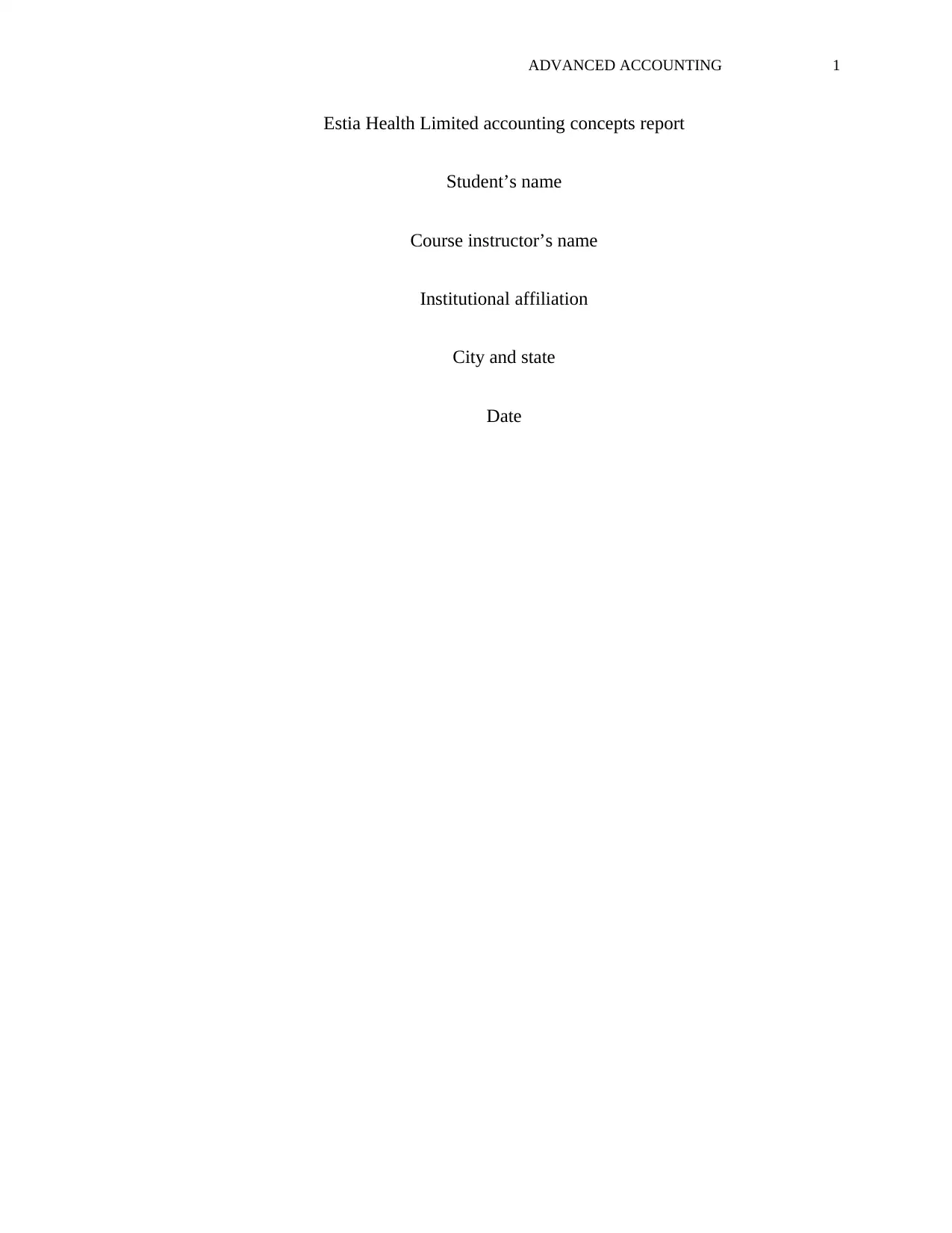
ADVANCED ACCOUNTING 1
Estia Health Limited accounting concepts report
Student’s name
Course instructor’s name
Institutional affiliation
City and state
Date
Estia Health Limited accounting concepts report
Student’s name
Course instructor’s name
Institutional affiliation
City and state
Date
Paraphrase This Document
Need a fresh take? Get an instant paraphrase of this document with our AI Paraphraser
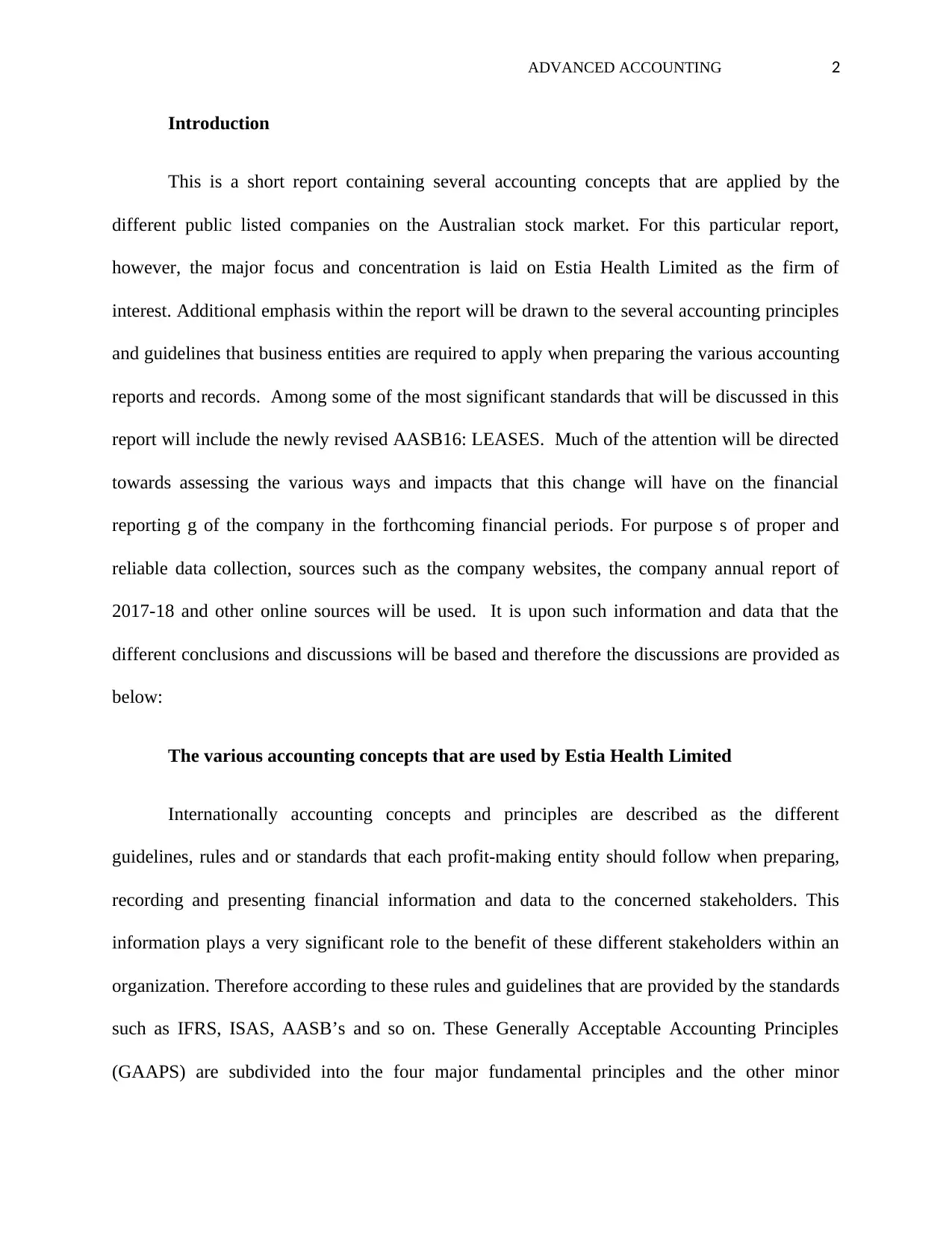
ADVANCED ACCOUNTING 2
Introduction
This is a short report containing several accounting concepts that are applied by the
different public listed companies on the Australian stock market. For this particular report,
however, the major focus and concentration is laid on Estia Health Limited as the firm of
interest. Additional emphasis within the report will be drawn to the several accounting principles
and guidelines that business entities are required to apply when preparing the various accounting
reports and records. Among some of the most significant standards that will be discussed in this
report will include the newly revised AASB16: LEASES. Much of the attention will be directed
towards assessing the various ways and impacts that this change will have on the financial
reporting g of the company in the forthcoming financial periods. For purpose s of proper and
reliable data collection, sources such as the company websites, the company annual report of
2017-18 and other online sources will be used. It is upon such information and data that the
different conclusions and discussions will be based and therefore the discussions are provided as
below:
The various accounting concepts that are used by Estia Health Limited
Internationally accounting concepts and principles are described as the different
guidelines, rules and or standards that each profit-making entity should follow when preparing,
recording and presenting financial information and data to the concerned stakeholders. This
information plays a very significant role to the benefit of these different stakeholders within an
organization. Therefore according to these rules and guidelines that are provided by the standards
such as IFRS, ISAS, AASB’s and so on. These Generally Acceptable Accounting Principles
(GAAPS) are subdivided into the four major fundamental principles and the other minor
Introduction
This is a short report containing several accounting concepts that are applied by the
different public listed companies on the Australian stock market. For this particular report,
however, the major focus and concentration is laid on Estia Health Limited as the firm of
interest. Additional emphasis within the report will be drawn to the several accounting principles
and guidelines that business entities are required to apply when preparing the various accounting
reports and records. Among some of the most significant standards that will be discussed in this
report will include the newly revised AASB16: LEASES. Much of the attention will be directed
towards assessing the various ways and impacts that this change will have on the financial
reporting g of the company in the forthcoming financial periods. For purpose s of proper and
reliable data collection, sources such as the company websites, the company annual report of
2017-18 and other online sources will be used. It is upon such information and data that the
different conclusions and discussions will be based and therefore the discussions are provided as
below:
The various accounting concepts that are used by Estia Health Limited
Internationally accounting concepts and principles are described as the different
guidelines, rules and or standards that each profit-making entity should follow when preparing,
recording and presenting financial information and data to the concerned stakeholders. This
information plays a very significant role to the benefit of these different stakeholders within an
organization. Therefore according to these rules and guidelines that are provided by the standards
such as IFRS, ISAS, AASB’s and so on. These Generally Acceptable Accounting Principles
(GAAPS) are subdivided into the four major fundamental principles and the other minor
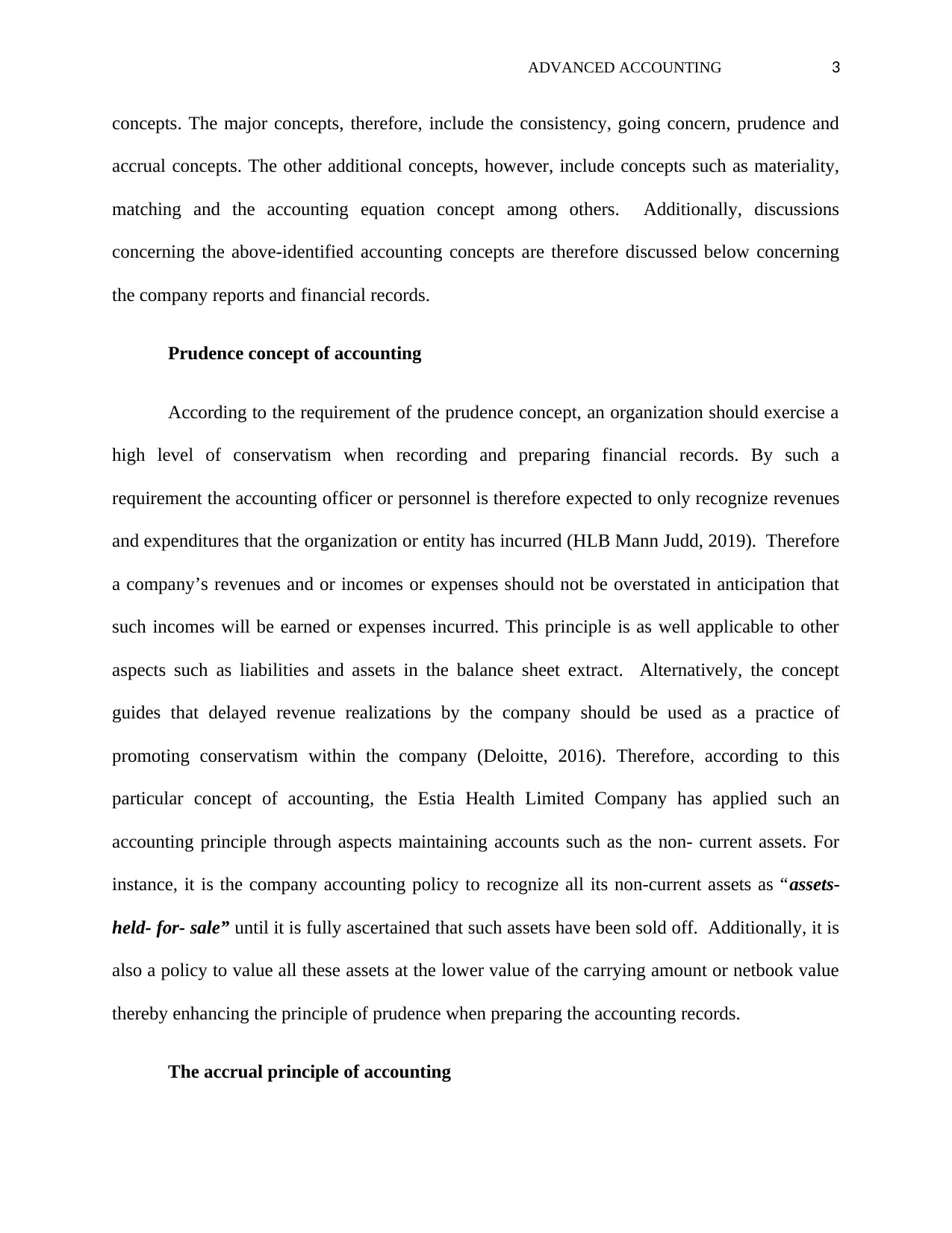
ADVANCED ACCOUNTING 3
concepts. The major concepts, therefore, include the consistency, going concern, prudence and
accrual concepts. The other additional concepts, however, include concepts such as materiality,
matching and the accounting equation concept among others. Additionally, discussions
concerning the above-identified accounting concepts are therefore discussed below concerning
the company reports and financial records.
Prudence concept of accounting
According to the requirement of the prudence concept, an organization should exercise a
high level of conservatism when recording and preparing financial records. By such a
requirement the accounting officer or personnel is therefore expected to only recognize revenues
and expenditures that the organization or entity has incurred (HLB Mann Judd, 2019). Therefore
a company’s revenues and or incomes or expenses should not be overstated in anticipation that
such incomes will be earned or expenses incurred. This principle is as well applicable to other
aspects such as liabilities and assets in the balance sheet extract. Alternatively, the concept
guides that delayed revenue realizations by the company should be used as a practice of
promoting conservatism within the company (Deloitte, 2016). Therefore, according to this
particular concept of accounting, the Estia Health Limited Company has applied such an
accounting principle through aspects maintaining accounts such as the non- current assets. For
instance, it is the company accounting policy to recognize all its non-current assets as “assets-
held- for- sale” until it is fully ascertained that such assets have been sold off. Additionally, it is
also a policy to value all these assets at the lower value of the carrying amount or netbook value
thereby enhancing the principle of prudence when preparing the accounting records.
The accrual principle of accounting
concepts. The major concepts, therefore, include the consistency, going concern, prudence and
accrual concepts. The other additional concepts, however, include concepts such as materiality,
matching and the accounting equation concept among others. Additionally, discussions
concerning the above-identified accounting concepts are therefore discussed below concerning
the company reports and financial records.
Prudence concept of accounting
According to the requirement of the prudence concept, an organization should exercise a
high level of conservatism when recording and preparing financial records. By such a
requirement the accounting officer or personnel is therefore expected to only recognize revenues
and expenditures that the organization or entity has incurred (HLB Mann Judd, 2019). Therefore
a company’s revenues and or incomes or expenses should not be overstated in anticipation that
such incomes will be earned or expenses incurred. This principle is as well applicable to other
aspects such as liabilities and assets in the balance sheet extract. Alternatively, the concept
guides that delayed revenue realizations by the company should be used as a practice of
promoting conservatism within the company (Deloitte, 2016). Therefore, according to this
particular concept of accounting, the Estia Health Limited Company has applied such an
accounting principle through aspects maintaining accounts such as the non- current assets. For
instance, it is the company accounting policy to recognize all its non-current assets as “assets-
held- for- sale” until it is fully ascertained that such assets have been sold off. Additionally, it is
also a policy to value all these assets at the lower value of the carrying amount or netbook value
thereby enhancing the principle of prudence when preparing the accounting records.
The accrual principle of accounting
⊘ This is a preview!⊘
Do you want full access?
Subscribe today to unlock all pages.

Trusted by 1+ million students worldwide
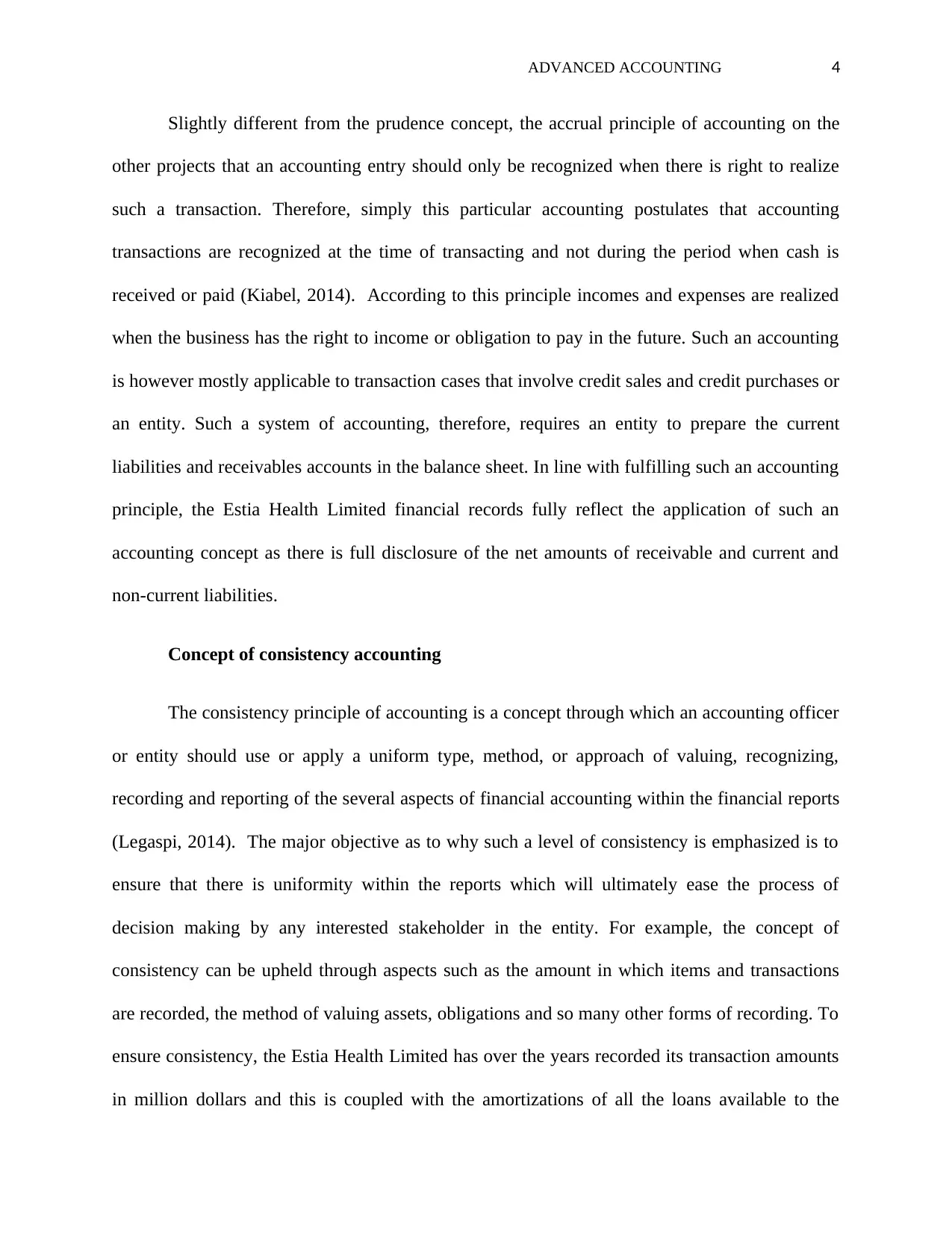
ADVANCED ACCOUNTING 4
Slightly different from the prudence concept, the accrual principle of accounting on the
other projects that an accounting entry should only be recognized when there is right to realize
such a transaction. Therefore, simply this particular accounting postulates that accounting
transactions are recognized at the time of transacting and not during the period when cash is
received or paid (Kiabel, 2014). According to this principle incomes and expenses are realized
when the business has the right to income or obligation to pay in the future. Such an accounting
is however mostly applicable to transaction cases that involve credit sales and credit purchases or
an entity. Such a system of accounting, therefore, requires an entity to prepare the current
liabilities and receivables accounts in the balance sheet. In line with fulfilling such an accounting
principle, the Estia Health Limited financial records fully reflect the application of such an
accounting concept as there is full disclosure of the net amounts of receivable and current and
non-current liabilities.
Concept of consistency accounting
The consistency principle of accounting is a concept through which an accounting officer
or entity should use or apply a uniform type, method, or approach of valuing, recognizing,
recording and reporting of the several aspects of financial accounting within the financial reports
(Legaspi, 2014). The major objective as to why such a level of consistency is emphasized is to
ensure that there is uniformity within the reports which will ultimately ease the process of
decision making by any interested stakeholder in the entity. For example, the concept of
consistency can be upheld through aspects such as the amount in which items and transactions
are recorded, the method of valuing assets, obligations and so many other forms of recording. To
ensure consistency, the Estia Health Limited has over the years recorded its transaction amounts
in million dollars and this is coupled with the amortizations of all the loans available to the
Slightly different from the prudence concept, the accrual principle of accounting on the
other projects that an accounting entry should only be recognized when there is right to realize
such a transaction. Therefore, simply this particular accounting postulates that accounting
transactions are recognized at the time of transacting and not during the period when cash is
received or paid (Kiabel, 2014). According to this principle incomes and expenses are realized
when the business has the right to income or obligation to pay in the future. Such an accounting
is however mostly applicable to transaction cases that involve credit sales and credit purchases or
an entity. Such a system of accounting, therefore, requires an entity to prepare the current
liabilities and receivables accounts in the balance sheet. In line with fulfilling such an accounting
principle, the Estia Health Limited financial records fully reflect the application of such an
accounting concept as there is full disclosure of the net amounts of receivable and current and
non-current liabilities.
Concept of consistency accounting
The consistency principle of accounting is a concept through which an accounting officer
or entity should use or apply a uniform type, method, or approach of valuing, recognizing,
recording and reporting of the several aspects of financial accounting within the financial reports
(Legaspi, 2014). The major objective as to why such a level of consistency is emphasized is to
ensure that there is uniformity within the reports which will ultimately ease the process of
decision making by any interested stakeholder in the entity. For example, the concept of
consistency can be upheld through aspects such as the amount in which items and transactions
are recorded, the method of valuing assets, obligations and so many other forms of recording. To
ensure consistency, the Estia Health Limited has over the years recorded its transaction amounts
in million dollars and this is coupled with the amortizations of all the loans available to the
Paraphrase This Document
Need a fresh take? Get an instant paraphrase of this document with our AI Paraphraser
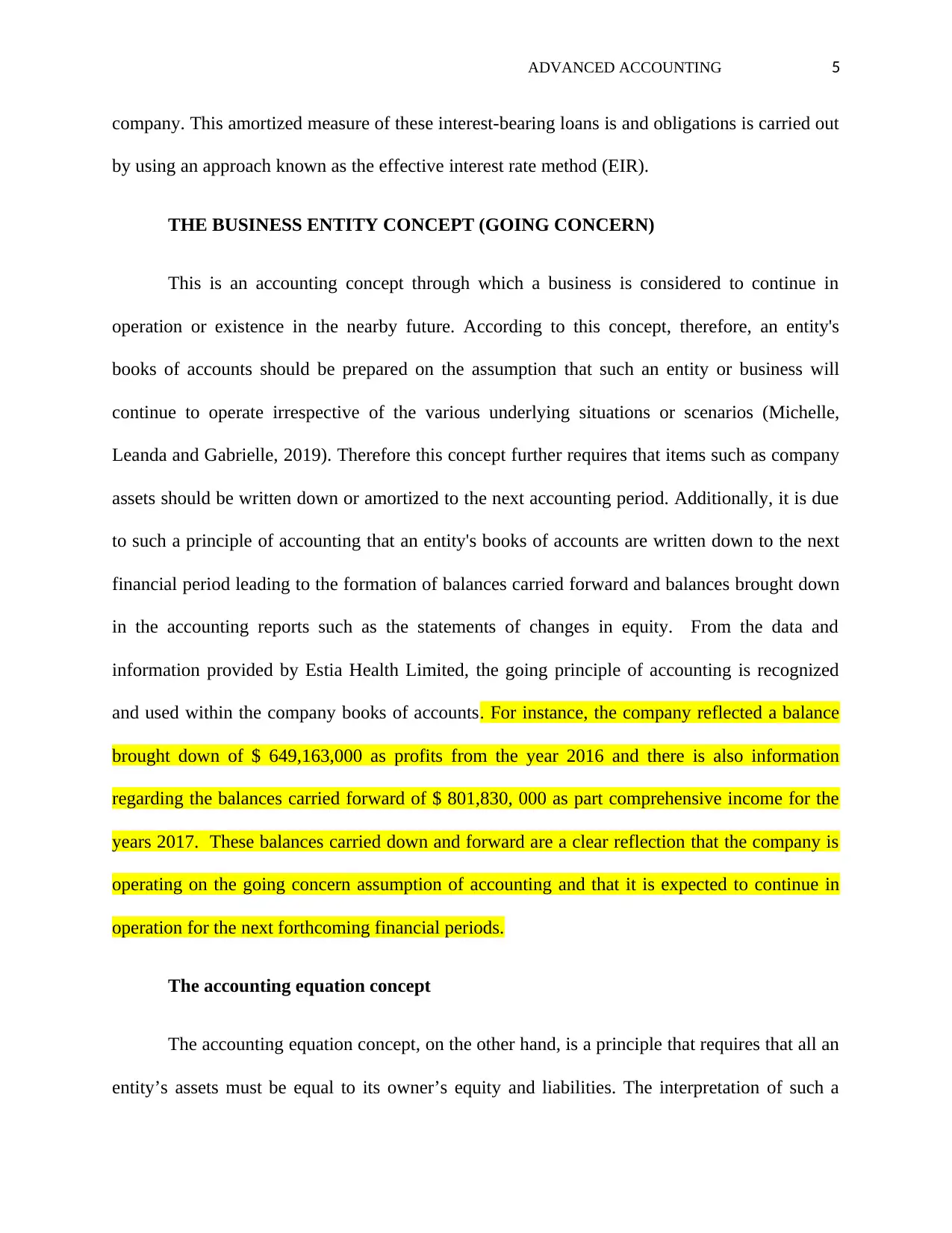
ADVANCED ACCOUNTING 5
company. This amortized measure of these interest-bearing loans is and obligations is carried out
by using an approach known as the effective interest rate method (EIR).
THE BUSINESS ENTITY CONCEPT (GOING CONCERN)
This is an accounting concept through which a business is considered to continue in
operation or existence in the nearby future. According to this concept, therefore, an entity's
books of accounts should be prepared on the assumption that such an entity or business will
continue to operate irrespective of the various underlying situations or scenarios (Michelle,
Leanda and Gabrielle, 2019). Therefore this concept further requires that items such as company
assets should be written down or amortized to the next accounting period. Additionally, it is due
to such a principle of accounting that an entity's books of accounts are written down to the next
financial period leading to the formation of balances carried forward and balances brought down
in the accounting reports such as the statements of changes in equity. From the data and
information provided by Estia Health Limited, the going principle of accounting is recognized
and used within the company books of accounts. For instance, the company reflected a balance
brought down of $ 649,163,000 as profits from the year 2016 and there is also information
regarding the balances carried forward of $ 801,830, 000 as part comprehensive income for the
years 2017. These balances carried down and forward are a clear reflection that the company is
operating on the going concern assumption of accounting and that it is expected to continue in
operation for the next forthcoming financial periods.
The accounting equation concept
The accounting equation concept, on the other hand, is a principle that requires that all an
entity’s assets must be equal to its owner’s equity and liabilities. The interpretation of such a
company. This amortized measure of these interest-bearing loans is and obligations is carried out
by using an approach known as the effective interest rate method (EIR).
THE BUSINESS ENTITY CONCEPT (GOING CONCERN)
This is an accounting concept through which a business is considered to continue in
operation or existence in the nearby future. According to this concept, therefore, an entity's
books of accounts should be prepared on the assumption that such an entity or business will
continue to operate irrespective of the various underlying situations or scenarios (Michelle,
Leanda and Gabrielle, 2019). Therefore this concept further requires that items such as company
assets should be written down or amortized to the next accounting period. Additionally, it is due
to such a principle of accounting that an entity's books of accounts are written down to the next
financial period leading to the formation of balances carried forward and balances brought down
in the accounting reports such as the statements of changes in equity. From the data and
information provided by Estia Health Limited, the going principle of accounting is recognized
and used within the company books of accounts. For instance, the company reflected a balance
brought down of $ 649,163,000 as profits from the year 2016 and there is also information
regarding the balances carried forward of $ 801,830, 000 as part comprehensive income for the
years 2017. These balances carried down and forward are a clear reflection that the company is
operating on the going concern assumption of accounting and that it is expected to continue in
operation for the next forthcoming financial periods.
The accounting equation concept
The accounting equation concept, on the other hand, is a principle that requires that all an
entity’s assets must be equal to its owner’s equity and liabilities. The interpretation of such a
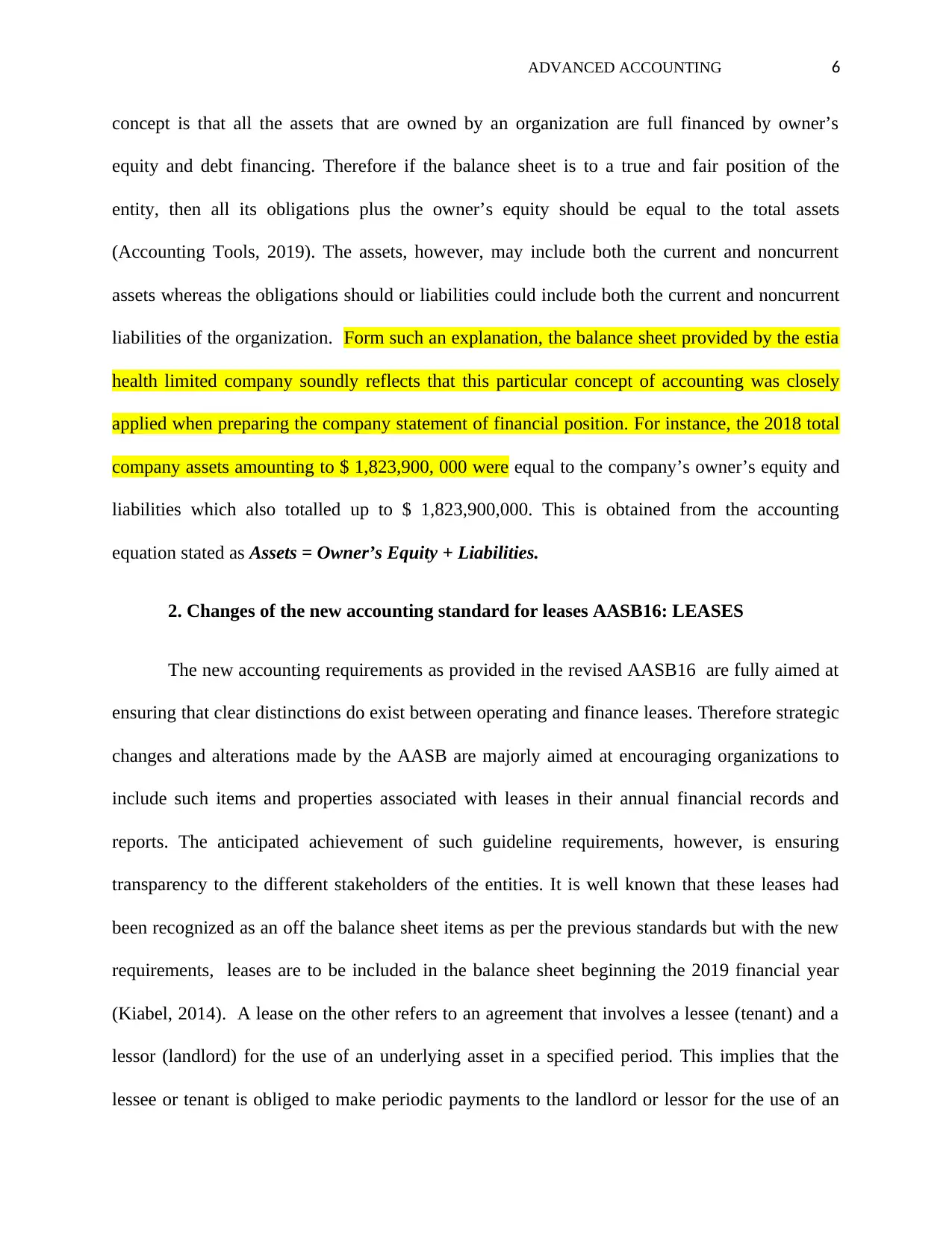
ADVANCED ACCOUNTING 6
concept is that all the assets that are owned by an organization are full financed by owner’s
equity and debt financing. Therefore if the balance sheet is to a true and fair position of the
entity, then all its obligations plus the owner’s equity should be equal to the total assets
(Accounting Tools, 2019). The assets, however, may include both the current and noncurrent
assets whereas the obligations should or liabilities could include both the current and noncurrent
liabilities of the organization. Form such an explanation, the balance sheet provided by the estia
health limited company soundly reflects that this particular concept of accounting was closely
applied when preparing the company statement of financial position. For instance, the 2018 total
company assets amounting to $ 1,823,900, 000 were equal to the company’s owner’s equity and
liabilities which also totalled up to $ 1,823,900,000. This is obtained from the accounting
equation stated as Assets = Owner’s Equity + Liabilities.
2. Changes of the new accounting standard for leases AASB16: LEASES
The new accounting requirements as provided in the revised AASB16 are fully aimed at
ensuring that clear distinctions do exist between operating and finance leases. Therefore strategic
changes and alterations made by the AASB are majorly aimed at encouraging organizations to
include such items and properties associated with leases in their annual financial records and
reports. The anticipated achievement of such guideline requirements, however, is ensuring
transparency to the different stakeholders of the entities. It is well known that these leases had
been recognized as an off the balance sheet items as per the previous standards but with the new
requirements, leases are to be included in the balance sheet beginning the 2019 financial year
(Kiabel, 2014). A lease on the other refers to an agreement that involves a lessee (tenant) and a
lessor (landlord) for the use of an underlying asset in a specified period. This implies that the
lessee or tenant is obliged to make periodic payments to the landlord or lessor for the use of an
concept is that all the assets that are owned by an organization are full financed by owner’s
equity and debt financing. Therefore if the balance sheet is to a true and fair position of the
entity, then all its obligations plus the owner’s equity should be equal to the total assets
(Accounting Tools, 2019). The assets, however, may include both the current and noncurrent
assets whereas the obligations should or liabilities could include both the current and noncurrent
liabilities of the organization. Form such an explanation, the balance sheet provided by the estia
health limited company soundly reflects that this particular concept of accounting was closely
applied when preparing the company statement of financial position. For instance, the 2018 total
company assets amounting to $ 1,823,900, 000 were equal to the company’s owner’s equity and
liabilities which also totalled up to $ 1,823,900,000. This is obtained from the accounting
equation stated as Assets = Owner’s Equity + Liabilities.
2. Changes of the new accounting standard for leases AASB16: LEASES
The new accounting requirements as provided in the revised AASB16 are fully aimed at
ensuring that clear distinctions do exist between operating and finance leases. Therefore strategic
changes and alterations made by the AASB are majorly aimed at encouraging organizations to
include such items and properties associated with leases in their annual financial records and
reports. The anticipated achievement of such guideline requirements, however, is ensuring
transparency to the different stakeholders of the entities. It is well known that these leases had
been recognized as an off the balance sheet items as per the previous standards but with the new
requirements, leases are to be included in the balance sheet beginning the 2019 financial year
(Kiabel, 2014). A lease on the other refers to an agreement that involves a lessee (tenant) and a
lessor (landlord) for the use of an underlying asset in a specified period. This implies that the
lessee or tenant is obliged to make periodic payments to the landlord or lessor for the use of an
⊘ This is a preview!⊘
Do you want full access?
Subscribe today to unlock all pages.

Trusted by 1+ million students worldwide
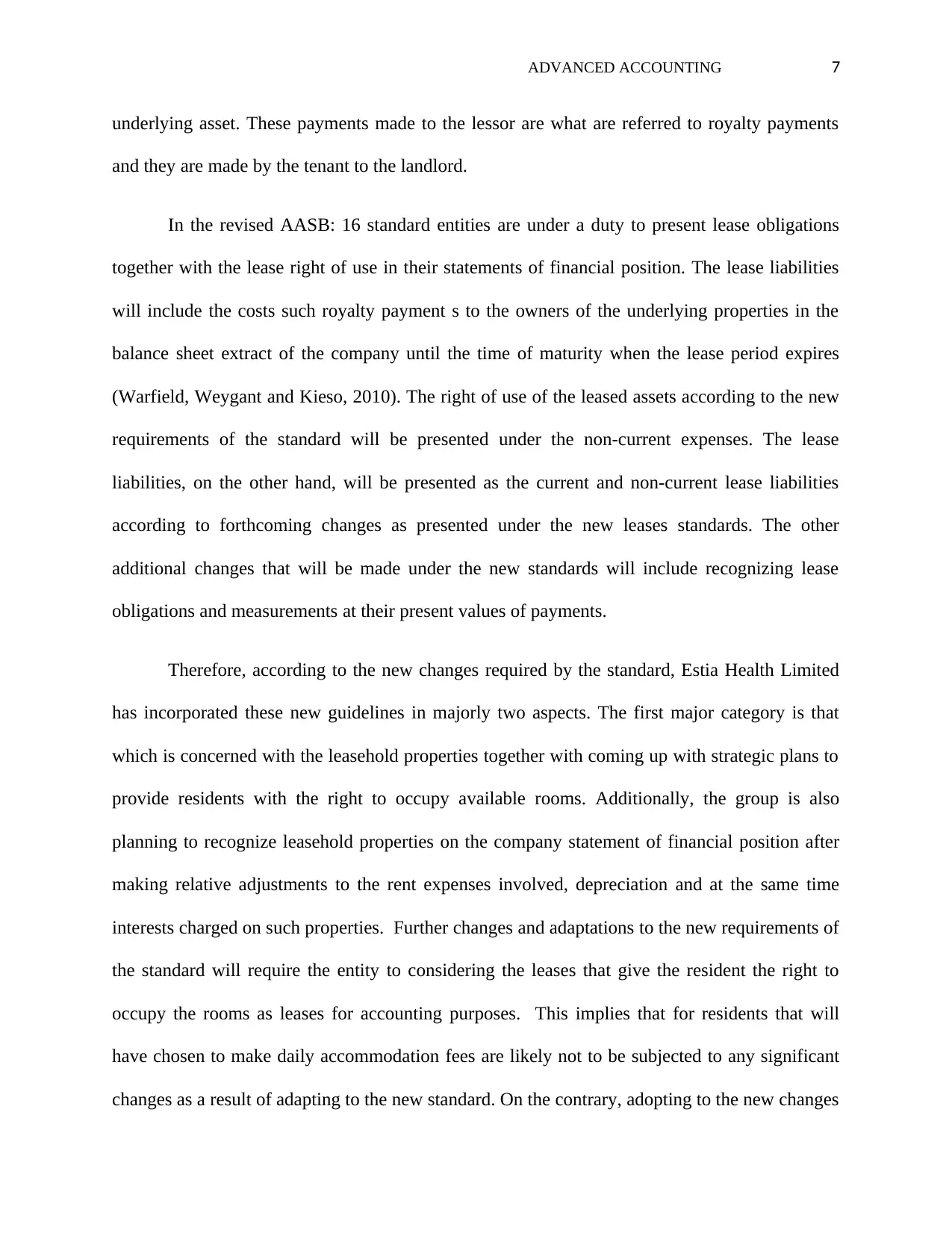
ADVANCED ACCOUNTING 7
underlying asset. These payments made to the lessor are what are referred to royalty payments
and they are made by the tenant to the landlord.
In the revised AASB: 16 standard entities are under a duty to present lease obligations
together with the lease right of use in their statements of financial position. The lease liabilities
will include the costs such royalty payment s to the owners of the underlying properties in the
balance sheet extract of the company until the time of maturity when the lease period expires
(Warfield, Weygant and Kieso, 2010). The right of use of the leased assets according to the new
requirements of the standard will be presented under the non-current expenses. The lease
liabilities, on the other hand, will be presented as the current and non-current lease liabilities
according to forthcoming changes as presented under the new leases standards. The other
additional changes that will be made under the new standards will include recognizing lease
obligations and measurements at their present values of payments.
Therefore, according to the new changes required by the standard, Estia Health Limited
has incorporated these new guidelines in majorly two aspects. The first major category is that
which is concerned with the leasehold properties together with coming up with strategic plans to
provide residents with the right to occupy available rooms. Additionally, the group is also
planning to recognize leasehold properties on the company statement of financial position after
making relative adjustments to the rent expenses involved, depreciation and at the same time
interests charged on such properties. Further changes and adaptations to the new requirements of
the standard will require the entity to considering the leases that give the resident the right to
occupy the rooms as leases for accounting purposes. This implies that for residents that will
have chosen to make daily accommodation fees are likely not to be subjected to any significant
changes as a result of adapting to the new standard. On the contrary, adopting to the new changes
underlying asset. These payments made to the lessor are what are referred to royalty payments
and they are made by the tenant to the landlord.
In the revised AASB: 16 standard entities are under a duty to present lease obligations
together with the lease right of use in their statements of financial position. The lease liabilities
will include the costs such royalty payment s to the owners of the underlying properties in the
balance sheet extract of the company until the time of maturity when the lease period expires
(Warfield, Weygant and Kieso, 2010). The right of use of the leased assets according to the new
requirements of the standard will be presented under the non-current expenses. The lease
liabilities, on the other hand, will be presented as the current and non-current lease liabilities
according to forthcoming changes as presented under the new leases standards. The other
additional changes that will be made under the new standards will include recognizing lease
obligations and measurements at their present values of payments.
Therefore, according to the new changes required by the standard, Estia Health Limited
has incorporated these new guidelines in majorly two aspects. The first major category is that
which is concerned with the leasehold properties together with coming up with strategic plans to
provide residents with the right to occupy available rooms. Additionally, the group is also
planning to recognize leasehold properties on the company statement of financial position after
making relative adjustments to the rent expenses involved, depreciation and at the same time
interests charged on such properties. Further changes and adaptations to the new requirements of
the standard will require the entity to considering the leases that give the resident the right to
occupy the rooms as leases for accounting purposes. This implies that for residents that will
have chosen to make daily accommodation fees are likely not to be subjected to any significant
changes as a result of adapting to the new standard. On the contrary, adopting to the new changes
Paraphrase This Document
Need a fresh take? Get an instant paraphrase of this document with our AI Paraphraser
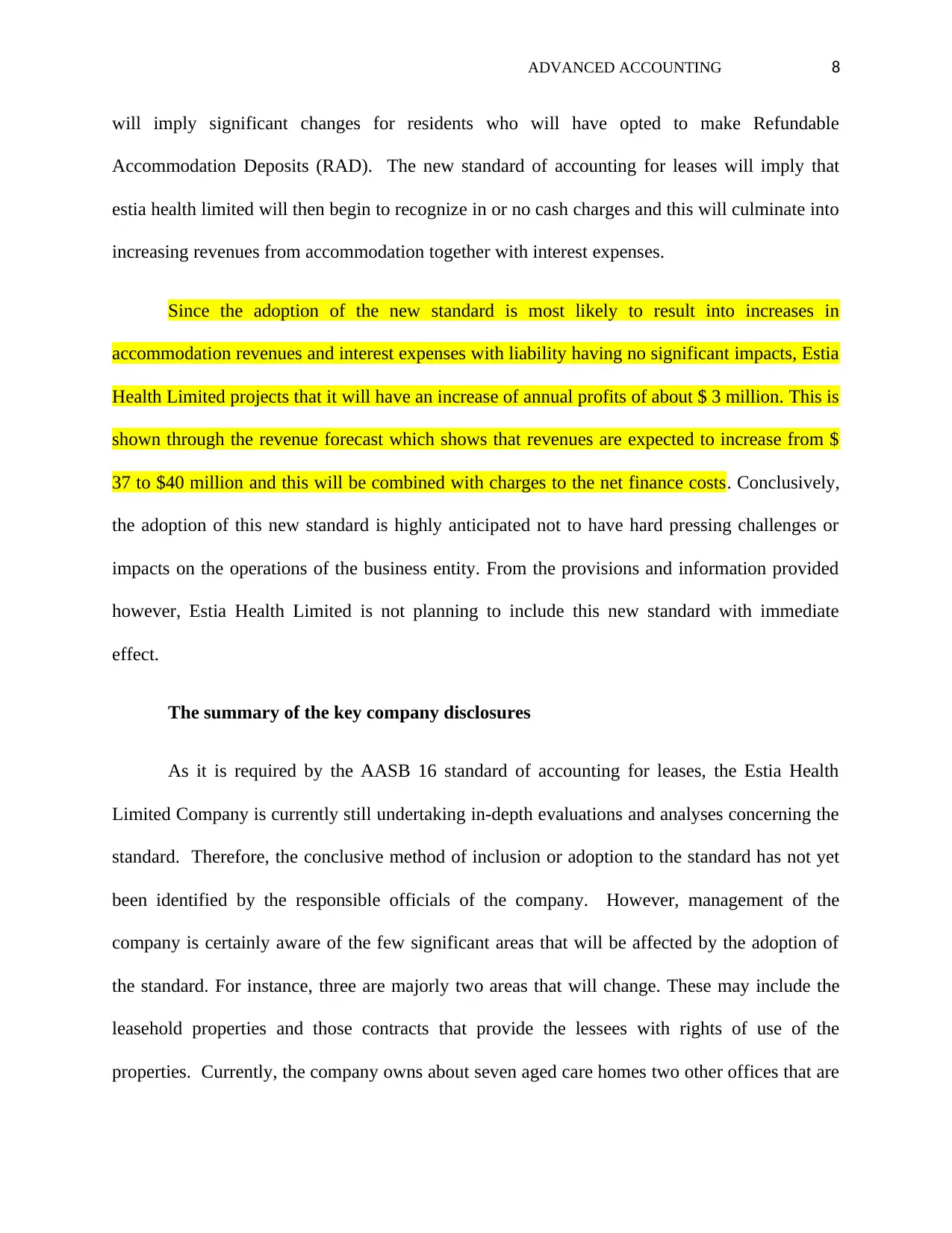
ADVANCED ACCOUNTING 8
will imply significant changes for residents who will have opted to make Refundable
Accommodation Deposits (RAD). The new standard of accounting for leases will imply that
estia health limited will then begin to recognize in or no cash charges and this will culminate into
increasing revenues from accommodation together with interest expenses.
Since the adoption of the new standard is most likely to result into increases in
accommodation revenues and interest expenses with liability having no significant impacts, Estia
Health Limited projects that it will have an increase of annual profits of about $ 3 million. This is
shown through the revenue forecast which shows that revenues are expected to increase from $
37 to $40 million and this will be combined with charges to the net finance costs. Conclusively,
the adoption of this new standard is highly anticipated not to have hard pressing challenges or
impacts on the operations of the business entity. From the provisions and information provided
however, Estia Health Limited is not planning to include this new standard with immediate
effect.
The summary of the key company disclosures
As it is required by the AASB 16 standard of accounting for leases, the Estia Health
Limited Company is currently still undertaking in-depth evaluations and analyses concerning the
standard. Therefore, the conclusive method of inclusion or adoption to the standard has not yet
been identified by the responsible officials of the company. However, management of the
company is certainly aware of the few significant areas that will be affected by the adoption of
the standard. For instance, three are majorly two areas that will change. These may include the
leasehold properties and those contracts that provide the lessees with rights of use of the
properties. Currently, the company owns about seven aged care homes two other offices that are
will imply significant changes for residents who will have opted to make Refundable
Accommodation Deposits (RAD). The new standard of accounting for leases will imply that
estia health limited will then begin to recognize in or no cash charges and this will culminate into
increasing revenues from accommodation together with interest expenses.
Since the adoption of the new standard is most likely to result into increases in
accommodation revenues and interest expenses with liability having no significant impacts, Estia
Health Limited projects that it will have an increase of annual profits of about $ 3 million. This is
shown through the revenue forecast which shows that revenues are expected to increase from $
37 to $40 million and this will be combined with charges to the net finance costs. Conclusively,
the adoption of this new standard is highly anticipated not to have hard pressing challenges or
impacts on the operations of the business entity. From the provisions and information provided
however, Estia Health Limited is not planning to include this new standard with immediate
effect.
The summary of the key company disclosures
As it is required by the AASB 16 standard of accounting for leases, the Estia Health
Limited Company is currently still undertaking in-depth evaluations and analyses concerning the
standard. Therefore, the conclusive method of inclusion or adoption to the standard has not yet
been identified by the responsible officials of the company. However, management of the
company is certainly aware of the few significant areas that will be affected by the adoption of
the standard. For instance, three are majorly two areas that will change. These may include the
leasehold properties and those contracts that provide the lessees with rights of use of the
properties. Currently, the company owns about seven aged care homes two other offices that are
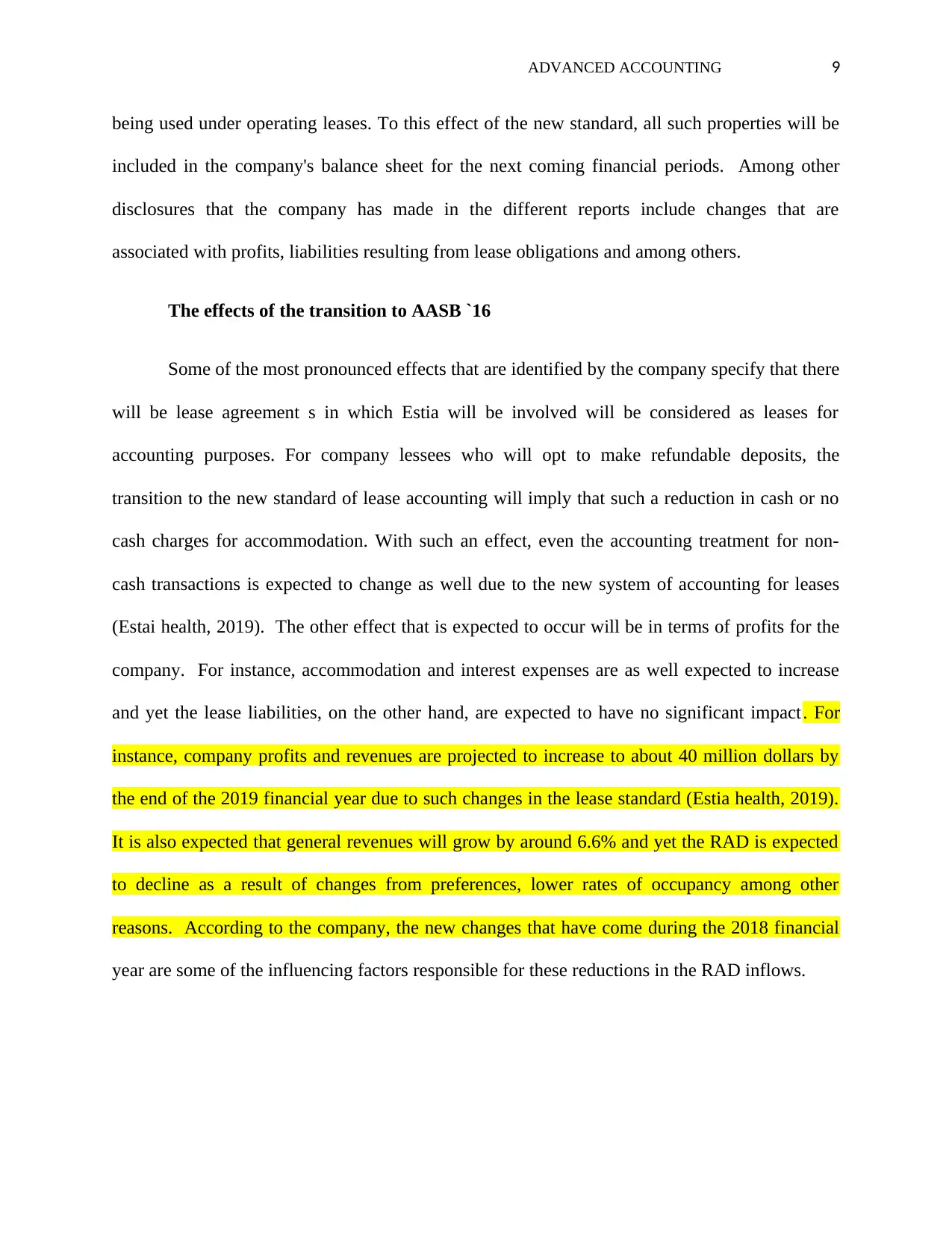
ADVANCED ACCOUNTING 9
being used under operating leases. To this effect of the new standard, all such properties will be
included in the company's balance sheet for the next coming financial periods. Among other
disclosures that the company has made in the different reports include changes that are
associated with profits, liabilities resulting from lease obligations and among others.
The effects of the transition to AASB `16
Some of the most pronounced effects that are identified by the company specify that there
will be lease agreement s in which Estia will be involved will be considered as leases for
accounting purposes. For company lessees who will opt to make refundable deposits, the
transition to the new standard of lease accounting will imply that such a reduction in cash or no
cash charges for accommodation. With such an effect, even the accounting treatment for non-
cash transactions is expected to change as well due to the new system of accounting for leases
(Estai health, 2019). The other effect that is expected to occur will be in terms of profits for the
company. For instance, accommodation and interest expenses are as well expected to increase
and yet the lease liabilities, on the other hand, are expected to have no significant impact. For
instance, company profits and revenues are projected to increase to about 40 million dollars by
the end of the 2019 financial year due to such changes in the lease standard (Estia health, 2019).
It is also expected that general revenues will grow by around 6.6% and yet the RAD is expected
to decline as a result of changes from preferences, lower rates of occupancy among other
reasons. According to the company, the new changes that have come during the 2018 financial
year are some of the influencing factors responsible for these reductions in the RAD inflows.
being used under operating leases. To this effect of the new standard, all such properties will be
included in the company's balance sheet for the next coming financial periods. Among other
disclosures that the company has made in the different reports include changes that are
associated with profits, liabilities resulting from lease obligations and among others.
The effects of the transition to AASB `16
Some of the most pronounced effects that are identified by the company specify that there
will be lease agreement s in which Estia will be involved will be considered as leases for
accounting purposes. For company lessees who will opt to make refundable deposits, the
transition to the new standard of lease accounting will imply that such a reduction in cash or no
cash charges for accommodation. With such an effect, even the accounting treatment for non-
cash transactions is expected to change as well due to the new system of accounting for leases
(Estai health, 2019). The other effect that is expected to occur will be in terms of profits for the
company. For instance, accommodation and interest expenses are as well expected to increase
and yet the lease liabilities, on the other hand, are expected to have no significant impact. For
instance, company profits and revenues are projected to increase to about 40 million dollars by
the end of the 2019 financial year due to such changes in the lease standard (Estia health, 2019).
It is also expected that general revenues will grow by around 6.6% and yet the RAD is expected
to decline as a result of changes from preferences, lower rates of occupancy among other
reasons. According to the company, the new changes that have come during the 2018 financial
year are some of the influencing factors responsible for these reductions in the RAD inflows.
⊘ This is a preview!⊘
Do you want full access?
Subscribe today to unlock all pages.

Trusted by 1+ million students worldwide
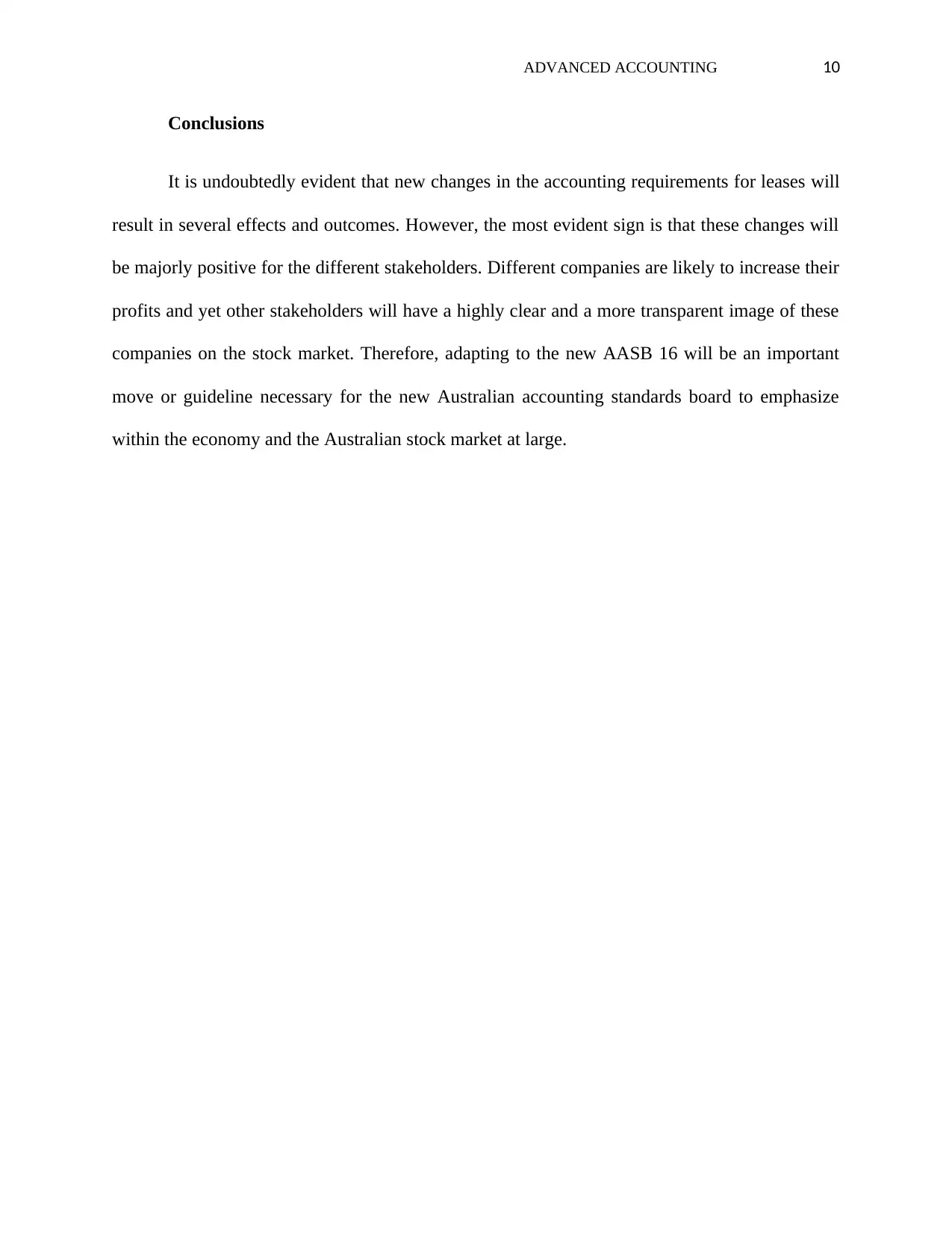
ADVANCED ACCOUNTING 10
Conclusions
It is undoubtedly evident that new changes in the accounting requirements for leases will
result in several effects and outcomes. However, the most evident sign is that these changes will
be majorly positive for the different stakeholders. Different companies are likely to increase their
profits and yet other stakeholders will have a highly clear and a more transparent image of these
companies on the stock market. Therefore, adapting to the new AASB 16 will be an important
move or guideline necessary for the new Australian accounting standards board to emphasize
within the economy and the Australian stock market at large.
Conclusions
It is undoubtedly evident that new changes in the accounting requirements for leases will
result in several effects and outcomes. However, the most evident sign is that these changes will
be majorly positive for the different stakeholders. Different companies are likely to increase their
profits and yet other stakeholders will have a highly clear and a more transparent image of these
companies on the stock market. Therefore, adapting to the new AASB 16 will be an important
move or guideline necessary for the new Australian accounting standards board to emphasize
within the economy and the Australian stock market at large.
Paraphrase This Document
Need a fresh take? Get an instant paraphrase of this document with our AI Paraphraser
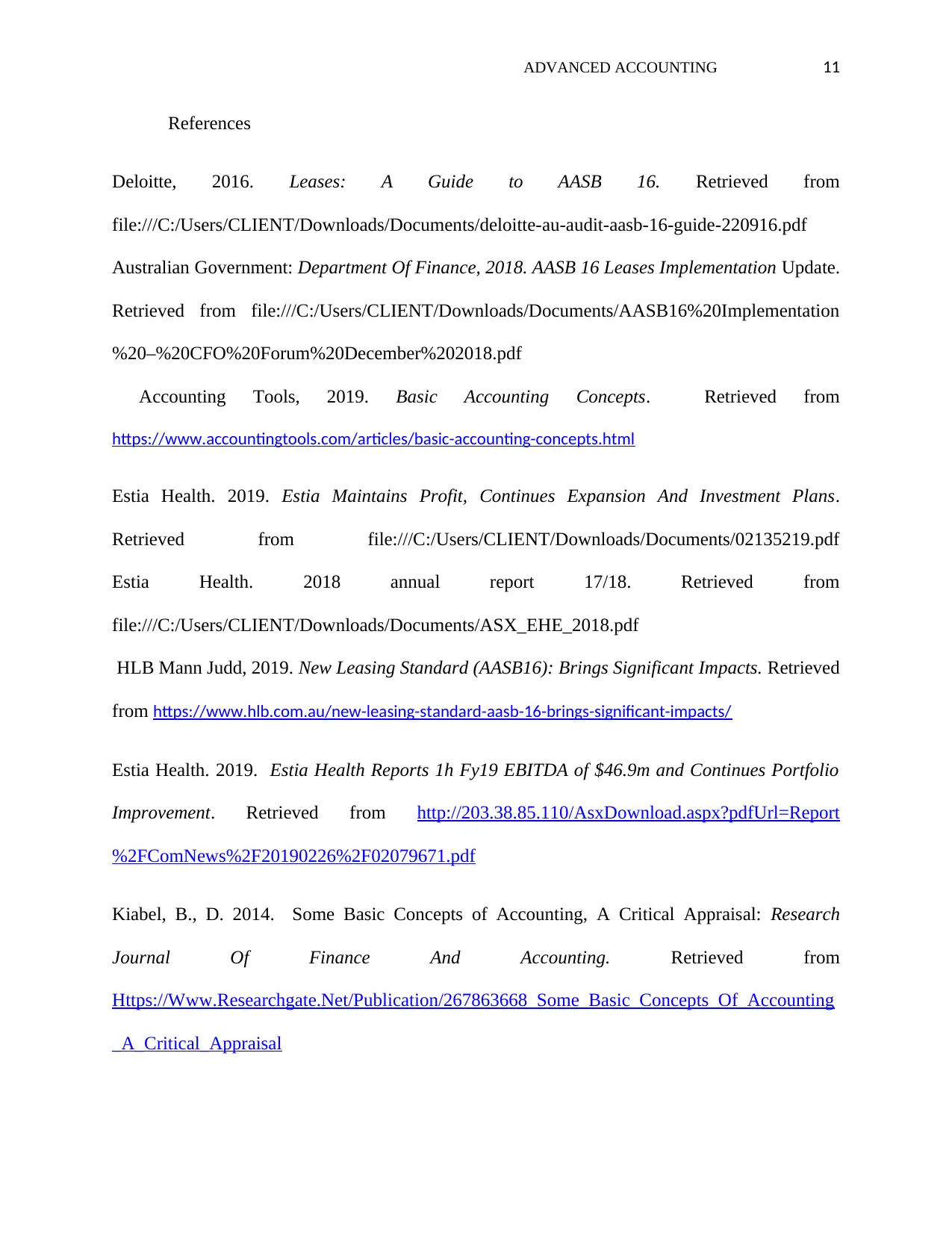
ADVANCED ACCOUNTING 11
References
Deloitte, 2016. Leases: A Guide to AASB 16. Retrieved from
file:///C:/Users/CLIENT/Downloads/Documents/deloitte-au-audit-aasb-16-guide-220916.pdf
Australian Government: Department Of Finance, 2018. AASB 16 Leases Implementation Update.
Retrieved from file:///C:/Users/CLIENT/Downloads/Documents/AASB16%20Implementation
%20–%20CFO%20Forum%20December%202018.pdf
Accounting Tools, 2019. Basic Accounting Concepts. Retrieved from
https://www.accountingtools.com/articles/basic-accounting-concepts.html
Estia Health. 2019. Estia Maintains Profit, Continues Expansion And Investment Plans.
Retrieved from file:///C:/Users/CLIENT/Downloads/Documents/02135219.pdf
Estia Health. 2018 annual report 17/18. Retrieved from
file:///C:/Users/CLIENT/Downloads/Documents/ASX_EHE_2018.pdf
HLB Mann Judd, 2019. New Leasing Standard (AASB16): Brings Significant Impacts. Retrieved
from https://www.hlb.com.au/new-leasing-standard-aasb-16-brings-significant-impacts/
Estia Health. 2019. Estia Health Reports 1h Fy19 EBITDA of $46.9m and Continues Portfolio
Improvement. Retrieved from http://203.38.85.110/AsxDownload.aspx?pdfUrl=Report
%2FComNews%2F20190226%2F02079671.pdf
Kiabel, B., D. 2014. Some Basic Concepts of Accounting, A Critical Appraisal: Research
Journal Of Finance And Accounting. Retrieved from
Https://Www.Researchgate.Net/Publication/267863668_Some_Basic_Concepts_Of_Accounting
_A_Critical_Appraisal
References
Deloitte, 2016. Leases: A Guide to AASB 16. Retrieved from
file:///C:/Users/CLIENT/Downloads/Documents/deloitte-au-audit-aasb-16-guide-220916.pdf
Australian Government: Department Of Finance, 2018. AASB 16 Leases Implementation Update.
Retrieved from file:///C:/Users/CLIENT/Downloads/Documents/AASB16%20Implementation
%20–%20CFO%20Forum%20December%202018.pdf
Accounting Tools, 2019. Basic Accounting Concepts. Retrieved from
https://www.accountingtools.com/articles/basic-accounting-concepts.html
Estia Health. 2019. Estia Maintains Profit, Continues Expansion And Investment Plans.
Retrieved from file:///C:/Users/CLIENT/Downloads/Documents/02135219.pdf
Estia Health. 2018 annual report 17/18. Retrieved from
file:///C:/Users/CLIENT/Downloads/Documents/ASX_EHE_2018.pdf
HLB Mann Judd, 2019. New Leasing Standard (AASB16): Brings Significant Impacts. Retrieved
from https://www.hlb.com.au/new-leasing-standard-aasb-16-brings-significant-impacts/
Estia Health. 2019. Estia Health Reports 1h Fy19 EBITDA of $46.9m and Continues Portfolio
Improvement. Retrieved from http://203.38.85.110/AsxDownload.aspx?pdfUrl=Report
%2FComNews%2F20190226%2F02079671.pdf
Kiabel, B., D. 2014. Some Basic Concepts of Accounting, A Critical Appraisal: Research
Journal Of Finance And Accounting. Retrieved from
Https://Www.Researchgate.Net/Publication/267863668_Some_Basic_Concepts_Of_Accounting
_A_Critical_Appraisal
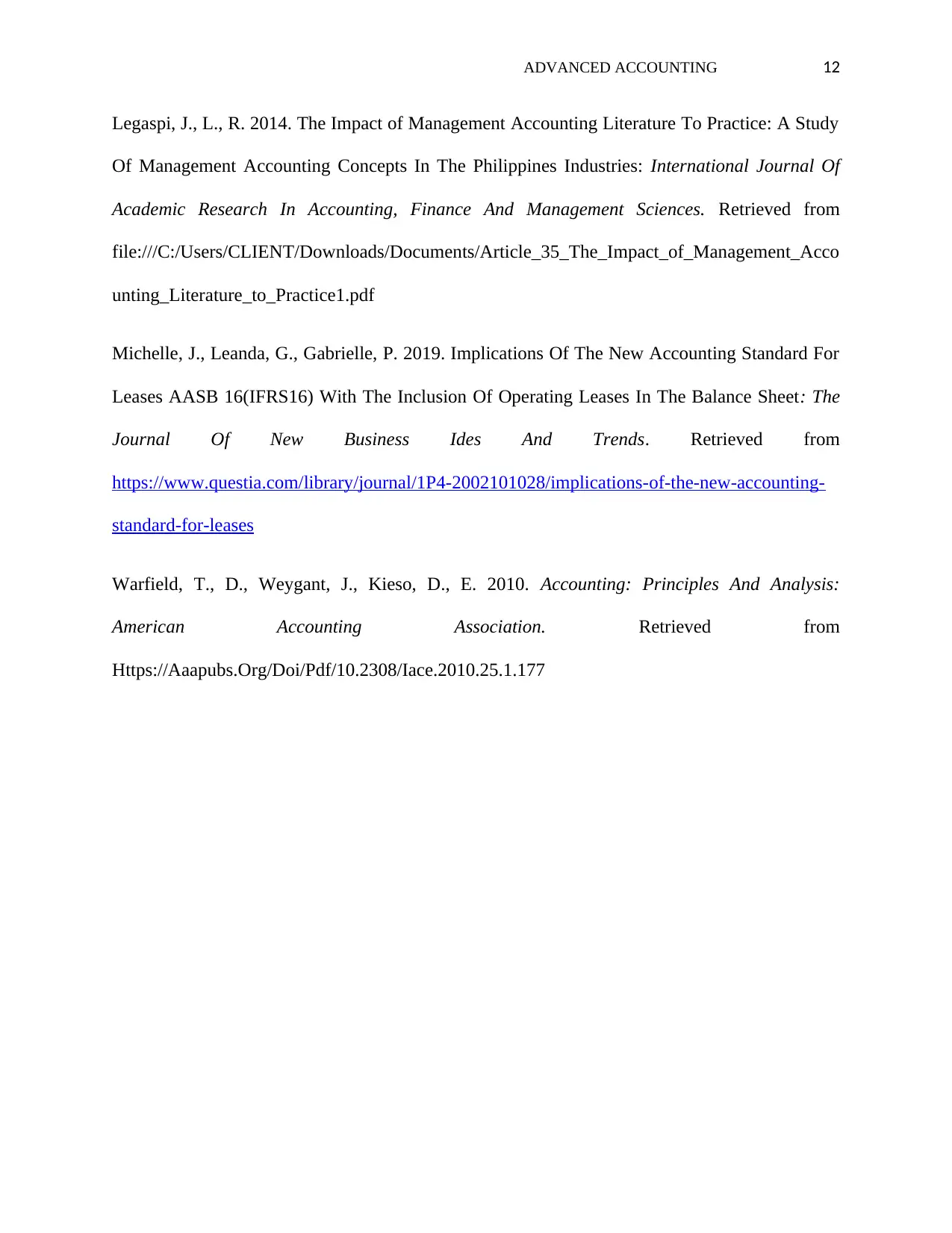
ADVANCED ACCOUNTING 12
Legaspi, J., L., R. 2014. The Impact of Management Accounting Literature To Practice: A Study
Of Management Accounting Concepts In The Philippines Industries: International Journal Of
Academic Research In Accounting, Finance And Management Sciences. Retrieved from
file:///C:/Users/CLIENT/Downloads/Documents/Article_35_The_Impact_of_Management_Acco
unting_Literature_to_Practice1.pdf
Michelle, J., Leanda, G., Gabrielle, P. 2019. Implications Of The New Accounting Standard For
Leases AASB 16(IFRS16) With The Inclusion Of Operating Leases In The Balance Sheet: The
Journal Of New Business Ides And Trends. Retrieved from
https://www.questia.com/library/journal/1P4-2002101028/implications-of-the-new-accounting-
standard-for-leases
Warfield, T., D., Weygant, J., Kieso, D., E. 2010. Accounting: Principles And Analysis:
American Accounting Association. Retrieved from
Https://Aaapubs.Org/Doi/Pdf/10.2308/Iace.2010.25.1.177
Legaspi, J., L., R. 2014. The Impact of Management Accounting Literature To Practice: A Study
Of Management Accounting Concepts In The Philippines Industries: International Journal Of
Academic Research In Accounting, Finance And Management Sciences. Retrieved from
file:///C:/Users/CLIENT/Downloads/Documents/Article_35_The_Impact_of_Management_Acco
unting_Literature_to_Practice1.pdf
Michelle, J., Leanda, G., Gabrielle, P. 2019. Implications Of The New Accounting Standard For
Leases AASB 16(IFRS16) With The Inclusion Of Operating Leases In The Balance Sheet: The
Journal Of New Business Ides And Trends. Retrieved from
https://www.questia.com/library/journal/1P4-2002101028/implications-of-the-new-accounting-
standard-for-leases
Warfield, T., D., Weygant, J., Kieso, D., E. 2010. Accounting: Principles And Analysis:
American Accounting Association. Retrieved from
Https://Aaapubs.Org/Doi/Pdf/10.2308/Iace.2010.25.1.177
⊘ This is a preview!⊘
Do you want full access?
Subscribe today to unlock all pages.

Trusted by 1+ million students worldwide
1 out of 12
Related Documents
Your All-in-One AI-Powered Toolkit for Academic Success.
+13062052269
info@desklib.com
Available 24*7 on WhatsApp / Email
![[object Object]](/_next/static/media/star-bottom.7253800d.svg)
Unlock your academic potential
Copyright © 2020–2025 A2Z Services. All Rights Reserved. Developed and managed by ZUCOL.





